
©2006 Howard "The Codex" Kistler
with minor updates 2015
ROOTS
What Is A Roguelike Game?
This is an informal history of a special genre of games, the roguelike game. Those of you unfamiliar with the term may be asking, "what is a roguelike game?" Well, it's a game that's like Rogue. More specifically, it's a game whose gameplay and presentation are similar to the game Rogue. Opinions vary on what exactly constitutes a roguelike, but at its heart it is a roleplaying game (RPG). This means it's a game where you create an alter ego and send them on quests through an imaginary world. Characters are typically defined in both RPGs and roguelikes by three basic sets of traits: attributes, race, and class.
Attributes are traits such as strength and intelligence and are represented by numerical values which determine such things as how well you can swing a sword or pick a lock. Other common attributes include "hit points", which track how much damage your character can take before it dies, and "experience", which is gained from successful actions and allows you to increase your attributes and acquire new abilities. Race is what species of (usually) sentient life your character belongs to. Some games only let you play as a Human, while others let you pick from fantasy standards like Elf and Dwarf, and still others let you choose an unusual race like Vampire or Cyclops. Class is essentially your character's career or area of expertise. As with race, some games offer no classes at all and you play a simple adventurer. Others let you pick from typical fantasy roles like Warrior, Wizard, or Priest, and a few give you more varied choices like Monk, Valkyrie, or Psychic.
Okay, so apart from the basic trappings of an RPG, what else do you get with a roguelike game? Well, one thing you get is text graphics. At the time roguelikes were first created, text was basically all that most computers could display. So text is used to create the imagery of the game world. Some of the text symbols chosen resemble what they represent, like a # for a piece of wall or a | for a sword. Other game entities like monsters are represented by the first letter of their type (such as the letter d standing in for a dragon), and the player is typically the @ sign (because that's where you're "at" in the game). You might think it requires a bit of imagination to turn a screen full of characters into a fantasy environment, and you'd be right. But there's something to be said for relying on internal visuals, which unlike other game graphics don't look dated after a couple years.
Something else you get with a roguelike game is the chance to die, permanently. A rarity in computer games today, the roguelikes take the arguably realistic stance of giving players only one life. Once this life is lost, there is no going back and loading it again for another try. You have to start all over with a fresh character. This also means that, just like real life, every action in the game is irrevokable.
Another thing roguelikes feature are randomized world. The game environment is generated randomly each time a new life is started. New dungeon layouts, different monster and item placement, and in some games new town and wilderness configurations, all add significantly to the replayability of roguelikes. Factor in the opportunity in most roguelikes to create unique characters and you end up with one game offering many different playing experiences.
So let's take a look at these roguelike games. We'll go through them in chronological order, so that you can see how they have improved and diverged over the years.
THE EARLY GAMES
DND
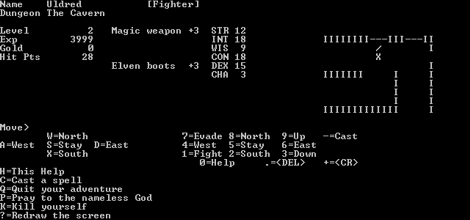
No polyhedral dice required
To understand where roguelike games come from you have to go back to 1970s and a social game called Dungeons & Dragons (D&D). D&D was the seminal RPG, drawn from the fantasy writings of authors such as J.R.R. Tolkien, Jack Vance, Robert E. Howard, and Fritz Lieber. The D&D world created a place for players to live out an alternate identity while encountering mythic monsters and enchanted artifacts. The whole experience was moderated by the "Dungeon Master", who populated the game world and its dungeons as well as controlling all characters and events apart from the players. (In roguelike games, the computer becomes the Dungeon Master.) And it was D&D that inspired the first roguelike game, the appropriately named DND.
In DND you create a character with the same 6 primary statistics as in D&D - strength, dexterity, constitution, intelligence, wisdom, and charisma. The D&D system proved to be a popular foundation, so we will see it again and again in the roguelikes that follow. Also like D&D, your character could be one of three basic classes - Fighter, Magician, or Cleric.
Once the basics of character creation are done, you select which of several dungeons you will enter to battle monsters and collect treasure. The creatures, spells, and equipment are straight out of D&D. (The monsters are even referred to as being of a particular "level", which in the original D&D indicates their comparative toughness.) Movement occurs in big jumps on a stylised map of the dungeon, and you come across creatures, items, and traps in individual one-on-one encounters. Play feels rather formalised and mechanical, and the game doesn't provide basic functions like mapping so you need to draw the maps yourself. It doesn't show spell lists or information about monsters either, so you'll also want the D&D guidebooks on hand when you play.
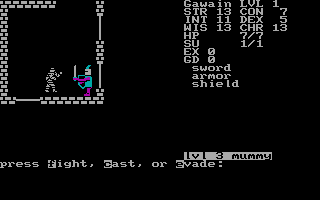
This is what "color graphics" once meant.
A commercial derivative of DND called Telengard was published for PCs by wargame mavens Avalon Hill. This game removes some of the complexity of the original, for example by making all players a kind of Fighter/Magician, but it is a bit easier to control. It also adds the dubious pleasure of animated graphics in the hideous four-color palette of CGA mode. An amusing variant, but more limited in scope than the original.
Rogue
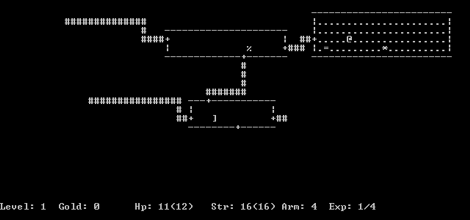
From me all things flow...
The next game to come along, and the one which the whole genre is named after, is Rogue. Something of a mixed bag, Rogue was both a step forward and a step back from DND.
Rogue is in many ways a simpler game than DND. There is no character creation to speak of, and you only have a few basic attributes like strength and hitpoints. However, there are numerous improvements which set it apart from DND, changes which became essential features later roguelikes would be expected to include.
One of the improvements is the addition of a genuine inventory for the player. Multiple potions, weapons, armors, and other goodies can be carried, and you decide when each item is equipt or used. The inventory is a vital addition for managing your character as an expansive catalogue of items becomes available.
Regarding items, Rogue also instituted another tradition that would perpetuate through later games. This is the concept of "flavored" unidentified items. Many items when found are unknowns to the player, beyond their obvious type (a sword, a potion, an amulet). Rogue adds a "flavor" to some item types to distinguish each from another unidentified item of the same type but with a different effect. For example, unknown potions will be flavored by their color ("you find a blue potion"), or scrolls by the magical gibberish written on them ("you have a scroll of 'ety brol uj zoi'"). The item's true nature is revealed upon use, which can lead to a new crisis ("a potion of confusion") or last-minute salvation ("a scroll of healing"). Weapons and armor likewise remain unidentified, so you never quite know if you are carrying an enchanted blade or a cursed sword until spell of Identify is read over it. Some items can even be named by the player, and all can be "inscribed" with shortcut keystrokes for easy use.
The biggest change in Rogue however is the dungeon itself. Gone is the abstracted environment of DND and in its place is a series of rooms joined by hallways. Each dungeon level takes up one screen and the player moves one space at a time through this grid-like world. Ranged weapons and spells fly through the open spaces, items litter the floors, and creatures move about as they attack or flee. The end result is a far more immersive experience, and one that has been imitated and improved in the years since.

That's way too many Ice Monsters to be smiling at, Mr. Happy Face Rogue.
Like DND with Telengard, Rogue would also enjoy a commercial release. Published by Epyx and involving some of the original Rogue creators, this version stayed faithful to the freely-available original. Color was added and a more graphical text font used, but the overall experience remains the same. This version has since been emulated and ported by other developers as well, and is probably the preferrable version to play if you can find it for your platform (and if you can cope with the replacement of the player's @ symbol with a smiley face).
Moria
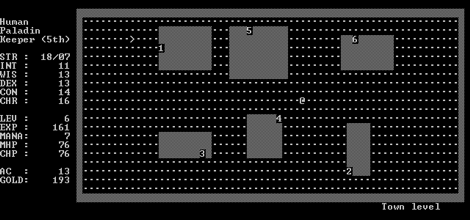
Welcome to the town with no name.
The next major roguelike game to come along took the basic formula of Rogue and expanded it in just about every direction. It wrapped deeper layers of the D&D and Tolkien source materials around the Rogue experience, and improved the game engine in myriad ways. The game is called The Dungeons Of Moria, though most people just call it Moria now.
The first thing you'll find when starting a game of Moria is that there are many more options for creating your character. No longer are you restricted to playing a human adventurer, but now you can elect to be from one of eight fantasy races, such as Elf or Dwarf. There are a greater variety of player classes to choose from, six in all, including such D&D stand-bys as Warrior, Mage, and Ranger. The six core attributes from D&D (and DND) make a welcome return, and intrinsic skills like Combat and Searching appear as well. You can even choose whether to be male or female, and while this has no statistical effect on your character, it helps reinforce the roleplaying aspect. Also adding to character flavor is the random "past and appearance" that is generated at creation time. Just like real life, in Moria you can't choose your family or your looks, but you can try to make the best of what you've got.
The next significant change from Rogue comes once you're done creating your persona. Instead of being dropped straight into the fray, you'll find yourself in a small town. Six basic shops like the General Store and the Weaponsmith buy and sell the items you'll need along your quest. And a quest it is, for just like its namesake, there's a Balrog waiting to be vanquished at the bottom of this Moria as well. This kind of overarching quest will appear again in later games, as it's a great mechanism for giving a driving narrative to the game, however basic.
Once you enter the dungeons, you'll discover more modifications to the Rogue world. Moria gives you more room to play, with dungeon layouts that sprawl across several screens. Levels are also "volatile", in that their layout changes whenever you leave them and they become restocked with monsters, items and traps. This makes it possible to repeat levels so that you can build yourself up more for the final confrontation. But ever-changing floorplans also mean losing dropped items and hunting for staircases.
Moria can be seen as an evolutionary step in roguelike games, widening the gaming experience by a large degree. It influenced most roguelikes which followed, and had a couple important descendants as well. The first is called Druid, a game employing some of the notable post-Moria enhancements. For one thing, the game is now in color, which makes spotting different monster types and item varieties much easier. It also includes the "autoroller", which allows you to influence your preferred character attributes up front so that you get a character more suited to the class you want to play. And speaking of classes, Druid adds a new one (can you guess what?) - the Druid, a character who is a mix of Mage and Priest and thus armed with both magic and holy prayers. Moria's other significant offspring, Angband, is one we'll come back to later.
Hack

Must...not...loot...
I would like to briefly mention another roguelike here, one called Hack. It is very similar to Rogue, being derived directly from it. About the only major change you'll notice at first is that you start the game in a shopping menu where you can buy starting items for your character. Otherwise it's largely indistinquishable from playing Rogue. It is worth mentioning this game however as it would later give birth to NetHack. NetHack is the biggest contender with the Angband games for "most popular roguelike". And as Angband has its genesis in Moria, so NetHack starts out humbly as Hack.
Larn

Look at all the goodies! Enlightenment rules!
The last of the early roguelikes we'll discuss is a unique entry called The Caves Of Larn, or just plain Larn to its friends. Larn, like Moria, uses the standard D&D six attributes system. However, there is no character creation per se. Instead you begin as an explorer with straight 12's in all your attributes. These attributes can be improved during play, and you can customize your character further by spending time and money at the College Of Larn.
Also like Moria, you have a primary quest in this game. The quest is more personal here, as you are entering the dungeon to find a rare potion which will cure your ailing daughter. This is a time-critical quest as you might expect, though you will occassionally find magic to rewind the hands of time, thereby giving you a few more precious turns.
Larn offers a world map, similar in some ways to the Moria town. There are a couple shops, the entrance to the dungeon, a bank, the LRS tax office, and the aforementionded College Of Larn. There is also an entrance to a volcanic shaft, which leads to a much deadlier dungeon. Time continues to tick away with each move above ground as well, so you'll need to take care of business and get back into the depths smartish.
The dungeons themselves are quite different than in previous roguelikes. Instead of a series of rooms connected by halls, each Larn level is a single screen labyrinth. The levels contain the usual staircases, but only occassionally doors, which typically lead into a lair-like room full of monsters and treasure. Levels also contain special features like fountains (which can be drunk from or bathed in), altars (which you can pray at, tithe to, or desecrate), thrones, pits, statues, and mirrors. Levels also remain consistent as you pass between them, which is important as you don't have time to spare in re-exploring them.
The total experience of playing Larn is a significant change from the other roguelikes, and the differences are largely positive. It remains something of a minority interest in the roguelike community today, and has few follow-up games. The most notable is ULarn, which adds a few new features and some simple character classes, but otherwise it is no major depature from the original Larn. Give either version a try if you've only played the better known roguelike games, or if you'd like to enjoy something different.
THE CURRENT CROP
NetHack

My puppy's name is Barky.
Now we get into the roguelike games that are still being developed and enhanced today. We'll start with NetHack, which we mentioned earlier when we took a quick glance at its Rogue-alike ancestor Hack.
NetHack offers the now common ability to customize your character to a large degree. You'll roll random attributes, assign a gender, and pick from one of five classic fantasy races. You'll also pick your character class from thirteen available choices, ranging from standards like Priest and Rogue to unusual types like Archeologist, Caveman, and Tourist. And for the first time, you'll get to pick your "alignment". Another concept borrowed from fantasy fiction via D&D, alignment dictates whether the role you're playing will be "lawful" (one who follows the rules), "chaotic" (one who is rebelliously independent or unpredictably maddened), or "neutral" (which can be anything from self-interest to complete amorality).
At first alignments may seem like a wonkish attempt to cram more D&D geekery into the game, but they actually serve a purpose. NetHack tracks the behaviour of your character and measures your actions, from how well you follow the dictates of your alignment to how pious you've been to whether you've refrained from eating meat. This kind of character profiling, and its often real effect on the game, shifts the emphasis in NetHack towards genuine roleplaying.
Another welcome addition is your pet. That's right, you'll start the game wandering the dungeon with your loyal puppy or kitten. Your little friend (which you can name) will generally follow you around and assist you by fetching items and helping you defeat monsters. If you can keep them from wandering away or getting smushed by tougher monsters, they'll grow and become a stronger ally as you journey deeper. It may seem like a minor addition, but having a travelling companion adds nicely to the game.
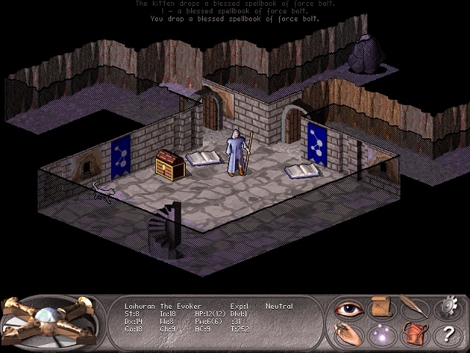
The Falcon's Eye sees pretty things. (screenshot courtesy Falcon's Eye site)
So while the dungeons may superficially resemble those of Hack, the underlying game is a more complex and enjoyable one. And if you simply must have graphics with your game, try the Falcon's Eye add-on. This module adds some lovely isometric graphics and realtime lighting to the game, while preserving the rich gameplay beneath. But with or without the graphics, NetHack is a game worth trying.
Angband
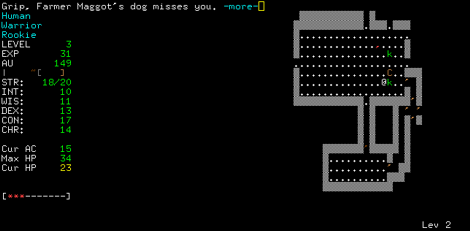
Must've smelled those mushrooms on me...
Originally titled The Pits Of Angband, but as is habit among roguelike games, the "The Blah Of" part of the title gets dropped in conversation and the game ends up being referred to as just plain Angband. But not so plain it turns out, as this particular descendant of Moria has spawned more offshoots than any other roguelike.
Initially Angband looks like only a minor updating of Moria. During character creation you'll notice a few more fantasy races to play, but so far so same-y. Once you appear in town, you'll notice that this game is in color. Color is a good thing, because Angband is fairly crammed with items and monsters and the colors will help you quickly distinguish between the various types. You'll also notice that the dungeons are rendered with some spiffy "light casting" techniques, which means that areas are visible to you in a far more realistic manner. The monsters are also more realistic, possessing individual behaviours and strategies. Some creatures will track you by sight, others by sound, and still others by smell. Some will only attack you in packs, and others will even learn from their encounters with you and try to exploit your weaknesses.
Angband also features "uniques". These are named one-of-a-kind items and monsters, often taken from fantasy fiction, and they sport special powers and attributes. You will frequently be made aware of the presence of these uniques by the "level feeling", which is a message that appears each time you enter a level. The level feeling gives you an idea of how much you might be challenged on the current dungeon floor, as well as hinting when specials are around.
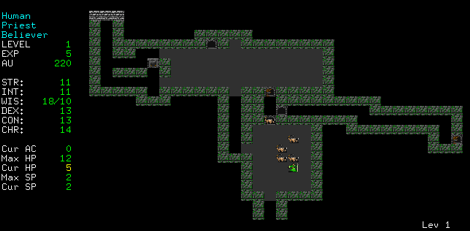
Some people like images better than text.
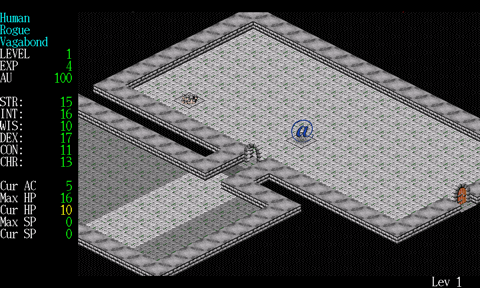
A little more engineering and it's Diabloband.
Angband also has its own graphical add-ons. There are several tilesets which are ready to use, and there is also an isometric engine in the works. These visuals may be shunned by roguelike gaming purists, but many new players like the addition of bitmapped graphics, so go with whatever you prefer.

The Angband Comic - It's funny because it's true.
Angband even had its own dedicated comic. The Angband Comic lovingly mocked the game while employing obscure references and slapstick humor. It ran for a good number of strips and has been fortunately returned to the web at http://angband.oook.cz/comic/.
As was mentioned earlier, Angband has spawned numerous descendants. A quick scan of an Angband spin-off list (like the one here - http://www.roguebasin.com/index.php?title=Angband_variants) turns up games like CthAngband (Angband retooled to reflect the Cthulhu Mythos writings of H.P. Lovecraft), PsiAngband (a variant featuring psychic characters and powers), MAngband (an online multiplayer version of Angband), and even Sillyband (a playable parody of the genre). But of all these derivatives, the two most popular (and most heavily modified) versions are ZAngband and ToME.
ZAngband

Town and country, ZAngband style.
ZAngband stands for "Zelazny Angband", as it originally took Angband and added in the contents of Roger Zelazny's 10-book fantasy opus, The Chronicles Of Amber. Races, monsters, items, places, and even a whole school of magic from the world of Amber are introduced into the Angband game. But ZAngband didn't stop there. Over the years it has incorporated the best ideas of other variants, as well as adding more of its own.
For example, ZAngband characters can now come from one of 25 races, ranging from fantasy standards to Zelazny races like Amberite and Beastman to exotic choices like Golem, Zombie, or Mindflayer. Five more classes are added to basic Moria ones, including the psychic Mindcrafter class. Mythological and Lovecraftian monsters wander the world next to Smeagol, Robin Hood, and sort-of former Finnish Prime Minister "Martti Ihrasaari" (don't ask). There are multiple towns scattered across a huge world map, and each contains a diverse array of specialty shops and buildings. You can pick up quests in towns as well as scouring the wilderness areas for monster camps to raid.
ZAngband offers more sheer content than any other roguelike, sometimes to a daunting degree. There are arguments that the volume of options makes the game harder in many respects, and indeed it can be one of the most difficult roguelikes to complete. Certainly by bringing in material from so many different sources there is the issue of game balance. But with so many options and so much to discover, even starting over after yet another demise isn't quite the hardship it might otherwise seem.
ToME
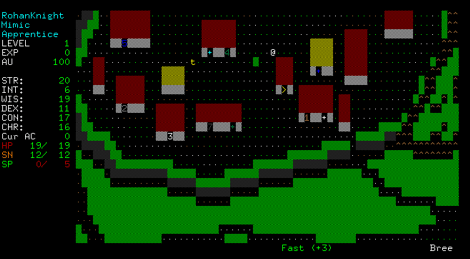
No, you can't bring Bill The Pony into the bar with you.
You thought you'd make it through this article with only a couple references to Tolkien, eh? And you very nearly would have, too, if it wasn't for ToME, a game which drips Lord Of The Rings from every pore. (Which is a bit ironic, as ToME started as a ZAngband variant called PernAngband, but the Pern materials had to be dropped due to copyright issues.)
ToME stands for Tales of Middle Earth, which should warn you immediately what you're in for. Sure enough, as soon as you start character creation, you're offered the chance to play from any number of Middle Earthian species, such as Wood-Elf, Beorning, and Ent, plus weirder entries like Maia and Death Mold. You'll also get the chance to pick a gender of "neuter", which one assumes is only natural when playing a fungoid creature or the like. Another interesting addition is "race modifiers", which allow you tweak your selected race by making them aberrant in some fashion, or even undead. And while the usual basic player types are present, there are also specializations which lets you focus your character even further. Rounding it all out is a chance to choose what god you worship, which is always nice.
The game interface lies neatly between the original Angband simplicity and the somewhat chaotic ZAngband one. Play is comfortably familiar to the Angband series, though creatures and items may vary subtley or markedly from what you encounter in other roguelikes. And of course just about every place, character, and quest is tied into the Middle Earth stories. So if that particular fictional world is your cup of tea, you may want to sit down with a copy of ToME some evening.
Omega
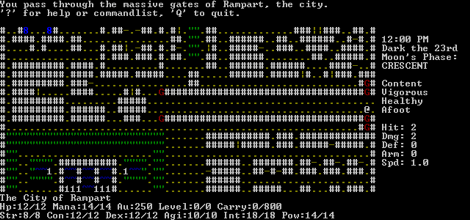
More data! More, I say!
One roguelike that makes a striking departure from previous titles is Omega. First up is the character generation screen, and right away you'll notice something unusual - you have the option of playing yourself. If you choose to do so, you'll be asked a variety of questions about things like how much weight you can lift and what score you received on an intelligence test. Answer honestly and you'll get a character based on you (or at least the what the game thinks you are). Otherwise you can roll up a random character who is defined by their basic attributes and, intriguingly, a question about whether your character is sexually attracted to men or women.
Once you create your character (or recreate yourself), you'll appear in the main city. Lots of additional information is immediately available, such as the current date on the fantasy calendar and the phase of the moon. The city is packed with interesting places, and the countryside holds danger for the unwary adventurer. There is a goodly amount of depth and fun to Omega which rewards the player patient enough to learn its distinct system.
ADOM
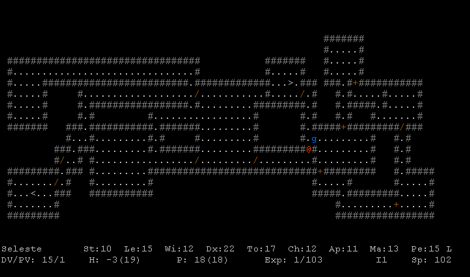
Good clean fun.
Innovation crops up again in one of the later popular roguelikes, a game called Ancient Domains Of Mystery (ADOM). Like Omega, there are rich options for creating a custom character. You'll start with a random birth sign, which in turn affects you with certain benefits and limitations. Then you'll pick your gender, race, and class from a large pool of choices. Finally you can modify your character either randomly or, more enjoyably, by choosing decisions from a series of multiple choice situational questions.
The game itself plays generally as a compromise between NetHack and Angband. Like NetHack, dungeon levels are single-screen affairs and shopping is of the grab-and-buy variety. The Angband bloodline shows through in the character depth and the combat/magic systems. There are little improvements and additions as well, such as much better dialogs with townsfolk and interesting wilderness encounters. Controls and game mechanics will be comfortable to players of other roguelikes, and the variety of the game world provides plenty of playability.
Dungeon Crawl

Forward into the past!
The latest roguelike release to build up a decent following is Dungeon Crawl. This game is a return to the roots, with basic character creation and non-stop dungeon exploring. Combat and item collecting are the order of the day here. The text graphics recall Angband, though with neat optimizations like autocentering and area lighting. There's not much more to say about this title, as it's something of a reductionist game. But its focus is sharp and well executed, and if you just want to get into a bout of bash-and-grab dungeoneering, this is the one to go with.
WHAT HATH ROGUE WROUGHT?

Rogue gets the Japanese art treatment in Fatal Labyrinth
The influence of Rogue persists today, and not just in the current roguelike games being developed. There are a number of other games based on the concepts and mechanics of the Rogue games. Fatal Labyrinth on the Sega Genesis/MegaDrive transplants a basic roguelike into a world of pleasing Japanese game graphics. A quirky 3D roguelike named Egoboo is available on the web and sports carefully constructed theme levels. Fans have ported other games to roguelike settings, including notable releases like Doom The Roguelike and the CastleVania Roguelike. But far and away the best known roguelike derivatives are the Diablo games from Blizzard. Diablo 1 & 2 borrow from roguelikes both basic gameplay and specific ideas (such as unique monsters and enchanted item sets) and wrap them in an intuitive isometric environment that also features online multiplay. The borrowing continues with the release of Space Hack, which isn't an updating of Hack so much as it's Diablo in space.
Roguelikes show no sign of stopping, spawning new titles and influencing games even now. There's an elegant purity at the heart of these games that can still draw us in and engage our imagination. But enough waxing on my part. Here are some links to start you on your own quest, and may you be challenged and delighted by what you find.
LINKS
GAMES
DND - http://dnd.lunaticsworld.com/
Rogue - http://home.wanadoo.nl/loche/rogue/index.html (Enhanced version via The Dungeons Of Doom)
http://www.prankster.com/winrogue/ (Windows port of DOS version)
Moria - http://www-math.bgsu.edu/~grabine/moria.html
http://www.piratehaven.org/~beej/moria/ (Windows version)
Hack - http://www.roguelikedevelopment.org/archive/index.php (Original versions can be found in this archive)
Larn - http://roguelikes.sauceforge.net/pub/larn/
Angband - http://www.thangorodrim.net
ZAngband - http://www.zangband.org
ToME - http://www.t-o-m-e.net/
NetHack - http://www.nethack.org/
Omega - http://www.alcyone.com/max/projects/omega/
http://www.prankster.com/winomega/ (Windows version)
ADOM - http://www.adom.de/
Dungeon Crawl - http://www.dungeoncrawl.org
Egoboo - http://egoboo.sourceforge.net/
Doom The Roguelike - http://doom.chaosforge.org/
CastleVania Roguelike - http://peltkore.net/~szdev/crl/
Diablo - http://www.blizzard.com/diablo/ & http://www.blizzard.com/diablo2/
Space Hack - http://www.rebelmind.com/spacehack/
The Roguelike Archive - http://www.roguelikedevelopment.org/archive/index.php
The Underdogs Roguelike Page - http://www.the-underdogs.info/genre.php?id=7&subgen=Roguelike
Falcon's Eye - http://users.tkk.fi/~jtpelto2/nethack.html
The RLTiles - http://rltiles.sourceforge.net/ (for NetHack and Dungeon Crawl)
Angband Tilesets - http://www.thangorodrim.net/download.html#graphics (for Angband and related)
Iso-Angband - http://www.simugraph.com/simutrans/iso_angband/
COMICS
The Angband Comic - http://angband.oook.cz/comic/
Tales From The Pit (a new Angband comic strip series) - http://angband.calamarain.net/
INFO
Dungeondweller - http://roguelikedevelopment.org/
BALROG Roguelike Information Site - http://tvilsom.org/roguelike/
RogueBasin WIKI - http://roguebasin.t-o-m-e.net/
FAQs.org Roguelikes Page - http://www.faqs.org/faqs/games/roguelike/info-ftp/
USENET
rec.games.roguelike.rogue
rec.games.roguelike.angband
rec.games.roguelike.nethack
rec.games.roguelike.adom
rec.games.roguelike.misc
rec.games.roguelike.announce
rec.games.roguelike.development